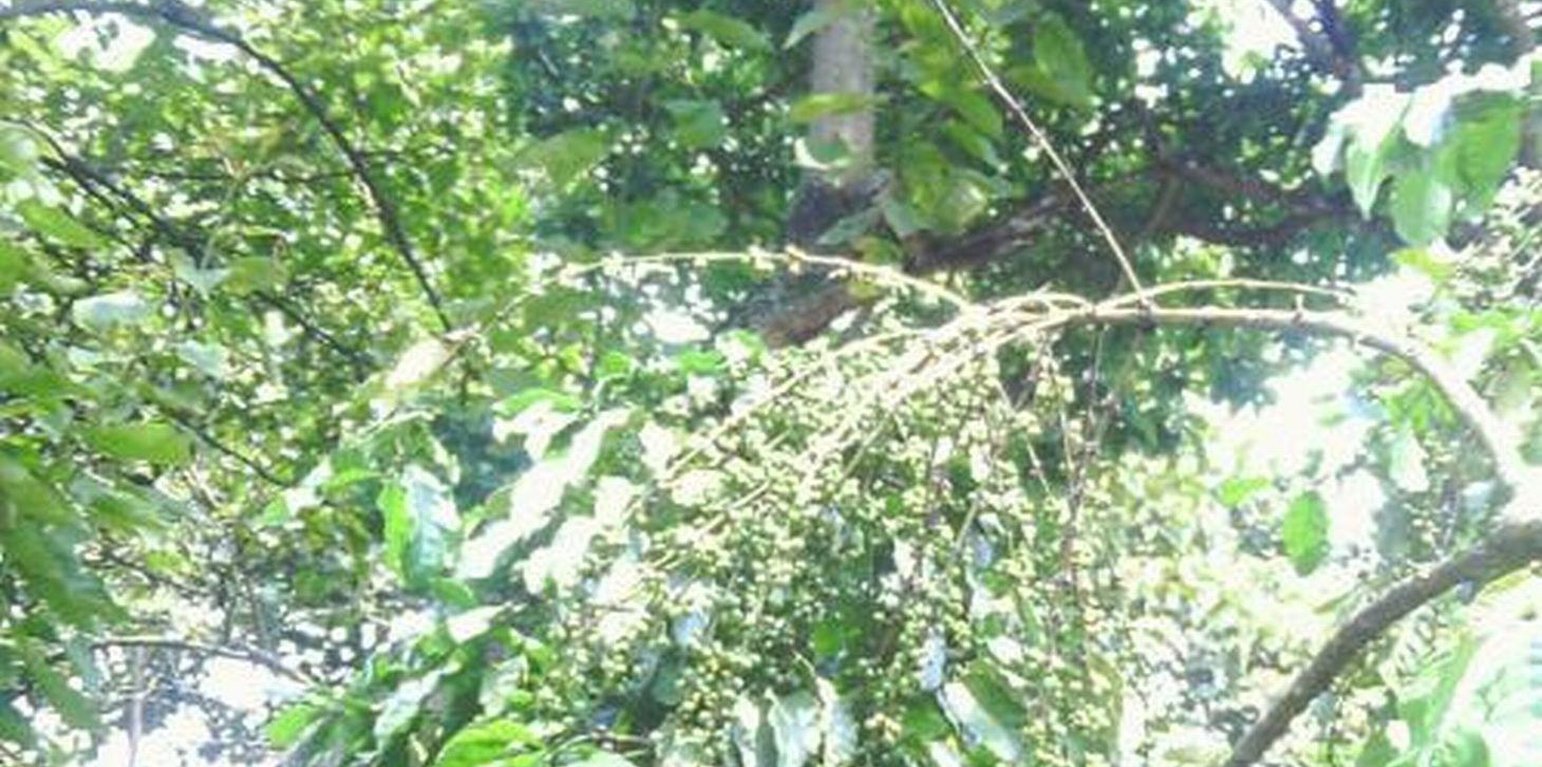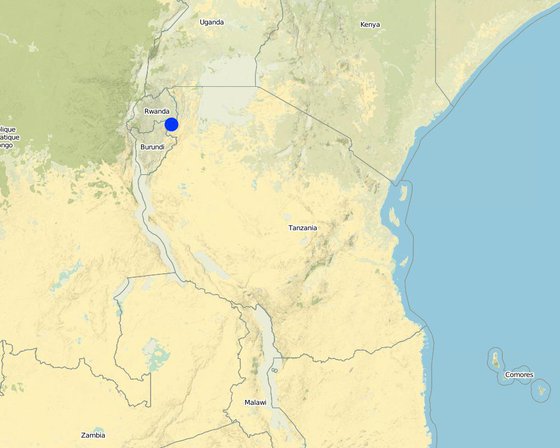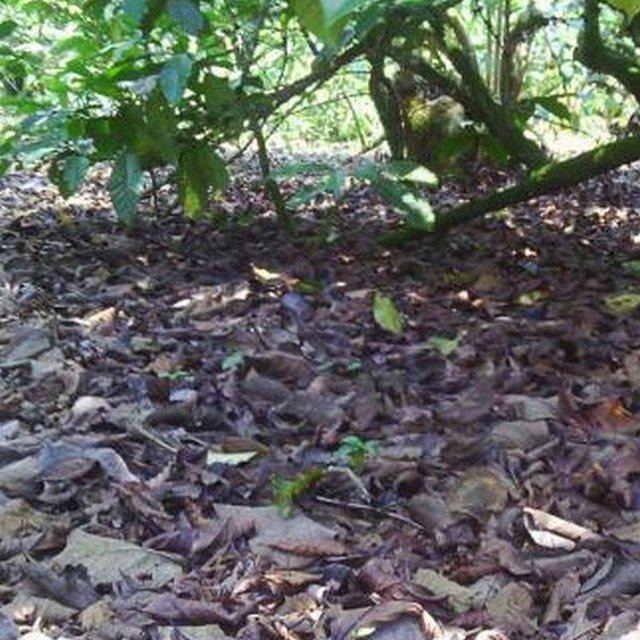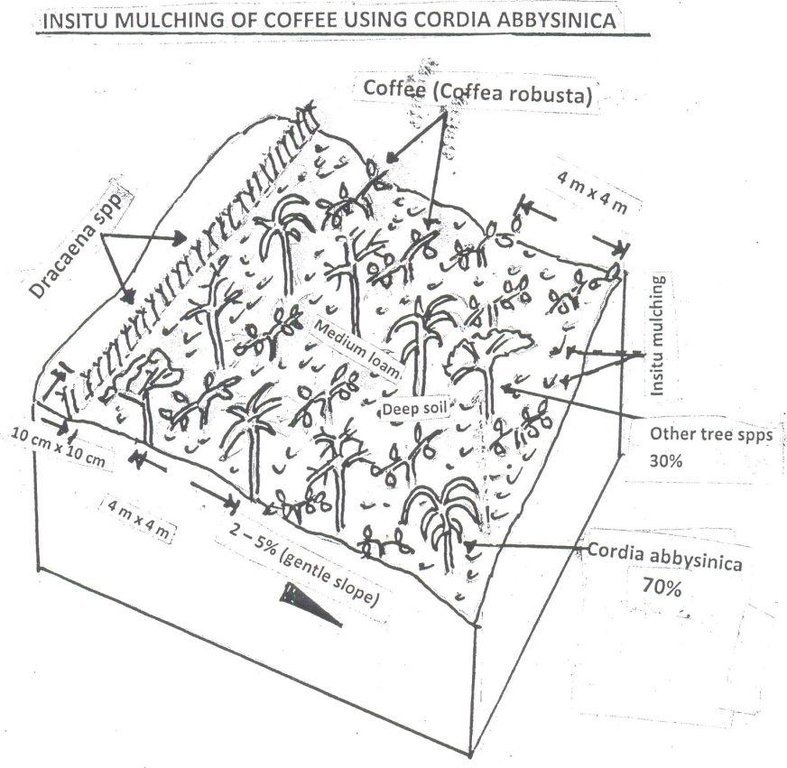



Establishment of Robusta coffee farms by an individual,on a cropland by mixing indigenous tree spp which provide a shade and dropping leaves save as natural mulch.The technology has been developed through land user initiatives over 40 years ago. Establishment activities include land clearing and preparation,preparation of holes,seed collection and planting which involve family labor Seeds are collected from neighboring village from mature trees. Holes are prepared randomly about 4 meters apart. No inputs are applied at the establishment stage only hand tools are used (hand hoe, matchet)
Shade trees are planted after establishment of coffee which are randomly planted, tree spp dominating is Cordia abbysinica which has broader leaves and easy to decompose.Other tree spp included are Erythrina,Meosopsis eminii,Ficus thornngii,Makhamia lutea and Tephrosia vogelii.
Maintenance include weeding which is done by pulling weeds by hand or using hand hoe at early stage after establishment because few leaves have dropped. The farm is mainly meant for coffee production however,few crops which are cassava bananas, fruit trees Jack fruit, Mangoes, Citrus spp which are planted in the peripherals,and Dracaena sppplanted to demarcate the farm along road side.
Pruning of tree branches is done before the shade is heavy as to allow ventilation.Coffee pruning is done to an individual tree depending on number of branches it has at time of harvesting, normally 4 branches are left. Bending of coffee branches is practiced to avoid branch breaking during harvesting.
Settlement is within the farm with few livestock which are sheep, cattle and chicken.
Purpose of the Technology: To increase coffee production by mixing coffee with indigenous tree spp which drop / shed its leaves.Selected trees are those broad leaved which its leaves decompose easily hence improve soil fertility and due to high accumulation of dropped leaves there is an increase in soil moisture content.
Trees act as wind break hence no flower drop.Dracaena spp are planted very close along the road side to demarcate his plot from neighbors and public infrastructure and this helps to reduce land conflicts among neighbors and community as well.
Hand weeding is done as the technology suppress weeds to the big shade.
Establishment / maintenance activities and inputs: A farmer bought a piece of land from the village government.Establishment activities include land clearance by removal of shrubs using a matchet.This is followed by land preparations and planting holes which are 30cm depth and 30cm width. These activities are done from May to July by family labor.Planting is normally done between September and October by collecting seedlings from mature trees in neighbors fields.Planting of indigenous tree spp is done randomly after coffee planting to allow ventilation 80 different spps are planted in 1.5 acres. Seeds and seedlings are obtained from neighbors farms.Maintenance includes weeding which is done using family labor who use hand hoe. This is done twice a year in May and December to January. Pruning and bending of coffee tree branches is done once per year after harvesting of coffee as well as trees in June and July using a matchet. Each coffee tree is treated individually only 4 branches are allowed per tree. Bending is done to avoid breaking of branches during coffee harvesting.
Gap filling is done few months after transplanting between February and March at the beginning of long rains. and this was followed pruning and bending of coffee branches.
Demarcation of coffee farm using Dracaena (shrub) done on one side of his farm along the road.
Natural / human environment: Land use type: Establishment of coffee has been done on crop land.
Agronomic: Natural mulch from leaves falling on ground.
Vegetative: Demarcation of boundary using Dracaena spp.
Climatic zone: Sub humid more than 269 growing days.
slope: 2-5% gentle slope
Soil type: Clay loam
Soil depth: Deep
Tools and inputs: Hand hoes,bush knife,axe, seeds and cuttings.
Land ownership: Individually owned.

ទីតាំង: Ngara District, Tanzania, ប្រទេសតង់សានី
ចំនួនទីកន្លែងបច្ចេកទេស ដែលវិភាគ:
ការសាយភាយនៃបច្ចេកទេស: ត្រូវបានផ្សព្វផ្សាយត្រឹមតំបន់មួយ (approx. < 0.1 គម2 (10 ហិកតា))
តើស្ថិតក្នុងតំបន់ការពារអចិន្ត្រៃយ៍?:
កាលបរិច្ឆេទនៃការអនុវត្ត: 10-50 ឆ្នាំ
ប្រភេទនៃការណែនាំឱ្យអនុវត្តន៍៖









| បញ្ជាក់ពីធាតុចូល | ឯកតា | បរិមាណ | ថ្លៃដើមក្នុងមួយឯកតា (Tanzanian shillings) | ថ្លៃធាតុចូលសរុប (Tanzanian shillings) | % នៃថ្លៃដើមដែលចំណាយដោយអ្នកប្រើប្រាស់ដី |
| កម្លាំងពលកម្ម | |||||
| labour | 1,0 | 2510,4 | 2510,4 | 100,0 | |
| សម្ភារៈ | |||||
| tools | 1,0 | 21,88 | 21,88 | 100,0 | |
| សម្ភារៈដាំដុះ | |||||
| seeds | 1,0 | 31,25 | 31,25 | 100,0 | |
| seedlings | 1,0 | 61,73 | 61,73 | 100,0 | |
| ថ្លៃដើមសរុបក្នុងការបង្កើតបច្ចេកទេស | 2'625.26 | ||||
| ថ្លៃដើមសរុបក្នុងការបង្កើតបច្ចេកទេសគិតជាដុល្លារ | 1.64 | ||||
| បញ្ជាក់ពីធាតុចូល | ឯកតា | បរិមាណ | ថ្លៃដើមក្នុងមួយឯកតា (Tanzanian shillings) | ថ្លៃធាតុចូលសរុប (Tanzanian shillings) | % នៃថ្លៃដើមដែលចំណាយដោយអ្នកប្រើប្រាស់ដី |
| កម្លាំងពលកម្ម | |||||
| labour | 1,0 | 63,63 | 63,63 | 100,0 | |
| សម្ភារៈដាំដុះ | |||||
| seedlings | 1,0 | 33,05 | 33,05 | 100,0 | |
| ថ្លៃដើមសរុបសម្រាប់ការថែទាំដំណាំតាមបច្ចេកទេស | 96.68 | ||||
| ថ្លៃដើមសរុបសម្រាប់ការថែទាំដំណាំតាមបច្ចេកទេសគិតជាដុល្លារ | 0.06 | ||||
គុណភាពមុន SLM: 16bags/ha
គុណភាពក្រោយ SLM: 58 bags/ha
គុណភាពមុន SLM: 3cub.m/ha
គុណភាពក្រោយ SLM: 12cub.m/ha
គុណភាពមុន SLM: 62 kg/ha
គុណភាពក្រោយ SLM: 0 kgs/ha
គុណភាពមុន SLM: 15 md/ha
គុណភាពក្រោយ SLM: 2 md/ha
គុណភាពមុន SLM: low
គុណភាពក្រោយ SLM: improved
គុណភាពមុន SLM: little
គុណភាពក្រោយ SLM: inreased
គុណភាពមុន SLM: none
គុណភាពក្រោយ SLM: available
គុណភាពមុន SLM: none
គុណភាពក្រោយ SLM: available
គុណភាពមុន SLM: low
គុណភាពក្រោយ SLM: high
គុណភាពមុន SLM: low
គុណភាពក្រោយ SLM: high
គុណភាពមុន SLM: low
គុណភាពក្រោយ SLM: high
គុណភាពមុន SLM: low
គុណភាពក្រោយ SLM: high
គុណភាពមុន SLM: low
គុណភាពក្រោយ SLM: medium
គុណភាពមុន SLM: low
គុណភាពក្រោយ SLM: medium